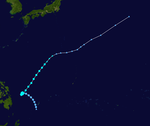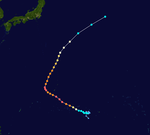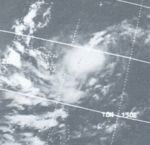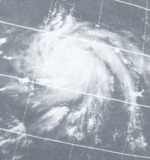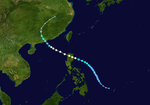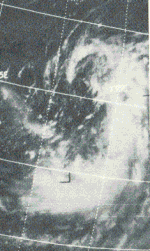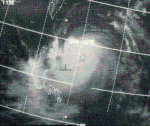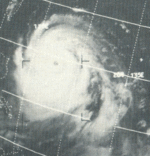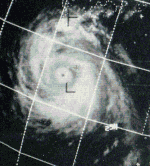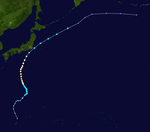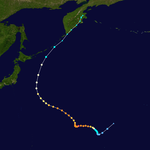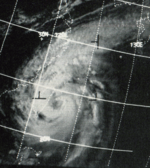1971 Pacific typhoon season
| 1971 Pacific typhoon season | |
|---|---|
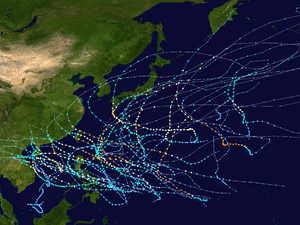 Season summary map | |
| Seasonal boundaries | |
| First system formed | January 7, 1971 |
| Last system dissipated | December 29, 1971 |
| Strongest storm | |
| Name | Irma |
| • Maximum winds | 285 km/h (180 mph) (1-minute sustained) |
| • Lowest pressure | 884 hPa (mbar) |
| Seasonal statistics | |
| Total depressions | 70 |
| Total storms | 35 |
| Typhoons | 24 |
| Super typhoons | 6 (unofficial) |
| Total fatalities | At least 617 total |
| Total damage | $57.7 million (1971 USD) |
| Related articles | |
The 1971 Pacific typhoon season was an extremely active season that featured the second highest typhoon count on record. It has no official bounds; it ran year-round in 1971, but most tropical cyclones tend to form in the northwestern Pacific Ocean between June and December. These dates conventionally delimit the period of each year when most tropical cyclones form in the northwestern Pacific Ocean.
The scope of this article is limited to the Pacific Ocean, north of the equator and west of the International Date Line. Storms that form east of the date line and north of the equator are called hurricanes; see 1971 Pacific hurricane season. Tropical Storms formed in the entire west pacific basin were assigned a name by the Joint Typhoon Warning Center. Tropical depressions in this basin have the "W" suffix added to their number. Tropical depressions that enter or form in the Philippine area of responsibility are assigned a name by the Philippine Weather Bureau, which would later be reformed into the Philippine Atmospheric, Geophysical and Astronomical Services Administration (PAGASA) the following year. This can often result in the same storm having two names.
Seasonal summary

| Most storms in a singular Pacific typhoon season (1955-present) | |||
|---|---|---|---|
| Year | Tropical storms | Typhoons | |
| Typhoons | Super typhoons | ||
| 1964 | 39 | 26 (record high) | 7 |
| 1994 | 36 | 20 | 6 |
| 1971 | 35 | 24 | 6 |
| 1965 | 35 | 21 | 11 (record high; tied with 1997) |
| 1961 | 35 | 20 | 8 |
| 1967 | 35 | 20 | 5 |
| 1989 | 32 | 20 | 5 |
| 1974 | 32 | 16 | 0 (record low) |
| 1992 | 31 | 16 | 5 |
| 1955 | 31 | 20 | 4 |
| 2013 | 31 | 13 | 5 |
| Note: Data begins at the year 1955 due to earlier data being increasingly unreliable. Totals for tropical storms and typhoons after 1964 are from the Japan Meteorological Agency, and totals for the unofficial super typhoon category are from the Joint Typhoon Warning Center. | |||
According to the United States Joint Typhoon Warning Center, the 1971 season was the most active season since 1967, with a total of 35 tropical storms being monitored by them during the year.[1] In addition to the 35 tropical storms, the Japan Meteorological Agency considered Tropical Depression 25W to be an additional tropical storm, which was only classified as a tropical depression by the JTWC.[2]
Systems
Severe Tropical Storm Sarah
| Severe tropical storm (JMA) | |
| Tropical storm (SSHWS) | |
| Duration | January 8 – January 11 |
|---|---|
| Peak intensity | 95 km/h (60 mph) (1-min); 990 hPa (mbar) |
During January 8, the JMA started to monitor a tropical depression that had developed, about 500 km (310 mi) to the east of Ngerulmud, Palau.[3] Over the next day the system gradually developed further as it moved north-westwards, before it was classified as a tropical storm and named Sarah by the JTWC, after a US Navy plane had found an organised system.[3][4] The system subsequently recurved north-eastwards, before it was classified as a Severe Tropical Storm by the JMA during January 10.[5] During that day, the JTWC reported that the system had peaked, with 1-minute sustained wind-speeds of 95 km/h (60 mph).[4] Over the next day, the system quickly weakened and became an extratropical cyclone during January 11.[4] Sarah's extratropical remnants were subsequently tracked as they moved north-eastwards, until it made landfall on Canada and broke up over the mountains of British Columbia during January 17.[4]
Tropical Storm Thelma (Bebeng)
| Tropical storm (JMA) | |
| Tropical storm (SSHWS) | |
| Duration | March 16 – March 21 |
|---|---|
| Peak intensity | 85 km/h (50 mph) (1-min); 994 hPa (mbar) |
On March 16, a tropical depression formed to the south of Guam. It immediately entered the Philippine Area of Responsibility, earning the local name Bebeng. It executed a small loop to the east of Mindanao before it traveled to the northwest. It exited the Area of Responsibility as a tropical storm before transitioning to an extratropical storm, southwest of Minami-Tori-shima. The extratropical storm weakened and dissipated on March 21, to the south-southeast of Japan.
Typhoon Vera (Karing)
| Typhoon (JMA) | |
| Category 2-equivalent typhoon (SSHWS) | |
| Duration | April 6 – April 19 |
|---|---|
| Peak intensity | 165 km/h (105 mph) (1-min); 965 hPa (mbar) |
Typhoon Wanda (Diding)
| Typhoon (JMA) | |
| Category 1-equivalent typhoon (SSHWS) | |
| Duration | April 22 – May 5 |
|---|---|
| Peak intensity | 140 km/h (85 mph) (1-min); 980 hPa (mbar) |
On April 23 Tropical Storm Wanda began its life to the east of the Philippines. It tracked over the archipelago, and emerged into the South China Sea on the 25th. It turned to the northwest, and became a typhoon on May 1 just off the coast of South Vietnam. The westerlies brought Wanda to the north and northeast, where it weakened until dissipating on the 4th near Hainan Island.
The storm caused 56 deaths (with 14 missing) and $700,000 in damage (1971 USD) from the heavy flooding across the Philippines.[6] While Wanda brushed the coast of Vietnam, the United States Army grounded most aircraft in northern areas and skirmishes related to the Vietnam War temporarily decreased until the storm passed by.[7] In Quảng Ngãi Province, 23 people were killed.[8]
Typhoon Amy
| Typhoon (JMA) | |
| Category 5-equivalent super typhoon (SSHWS) | |
| Duration | April 27 – May 7 |
|---|---|
| Peak intensity | 280 km/h (175 mph) (1-min); 890 hPa (mbar) |
According to the JTWC best track, Amy was first noted as a tropical depression early on April 29. Amy reached tropical storm status shortly afterwards, and became a typhoon by early on May 1. The cyclone then rapidly intensified into a Category 5 super typhoon with 1-minute sustained winds of 280 km/h (175 mph) on May 2, with the JMA estimating a minimum central pressure of 890 mb (hPa; 26.28 inHg),[9] although the JTWC estimated a slightly higher pressure of 895 mbar (hPa; 26.43 inHg), while noting a compact eye 10 nautical miles across.[10] Although Amy weakened to a Category 4 super typhoon on May 3, it regained Category 5 intensity later that day, with 1-minute sustained winds of 260 km/h (160 mph) and a central pressure of 900 mb (hPa; 26.58 inHg). The storm began to weaken by May 4 and was last noted as producing tropical-storm force winds on May 7,[11] after which Amy was absorbed by a frontal system.[10]
In deepening to 890 mb, Amy became the most intense typhoon on record in May.[12][13] On Truk Atoll, now known as Chuuk Atoll, one person was killed after a coconut tree fell on him.[14] On May 18, the Federated States of Micronesia was declared a disaster area by the Federal Emergency Management Agency.[15] The weather station and over 2,250 homes were destroyed on Namonuito Atoll.[10]
Severe Tropical Storm Babe (Etang)
| Severe tropical storm (JMA) | |
| Tropical storm (SSHWS) | |
| Duration | May 2 – May 7 |
|---|---|
| Peak intensity | 100 km/h (65 mph) (1-min); 990 hPa (mbar) |
Severe Tropical Storm Carla (Gening)
| Severe tropical storm (JMA) | |
| Tropical storm (SSHWS) | |
| Duration | May 17 – May 23 |
|---|---|
| Peak intensity | 95 km/h (60 mph) (1-min); 995 hPa (mbar) |
Typhoon Dinah (Herming)
| Typhoon (JMA) | |
| Category 2-equivalent typhoon (SSHWS) | |
| Duration | May 23 – May 31 |
|---|---|
| Peak intensity | 165 km/h (105 mph) (1-min); 960 hPa (mbar) |
Across the Philippines, 13 people were killed and another 14 were reported missing. Total damage in the country reached ₱4 million.[6]
Tropical Storm Emma (Ising)
| Tropical storm (JMA) | |
| Tropical storm (SSHWS) | |
| Duration | May 27 – June 3 |
|---|---|
| Peak intensity | 65 km/h (40 mph) (1-min); 1000 hPa (mbar) |
Typhoon Freda (Luding)
| Typhoon (JMA) | |
| Category 1-equivalent typhoon (SSHWS) | |
| Duration | June 9 – June 19 |
|---|---|
| Peak intensity | 140 km/h (85 mph) (1-min); 980 hPa (mbar) |
Typhoon Gilda (Mameng)
| Typhoon (JMA) | |
| Category 2-equivalent typhoon (SSHWS) | |
| Duration | June 22 – June 28 |
|---|---|
| Peak intensity | 165 km/h (105 mph) (1-min); 975 hPa (mbar) |
One person was killed and damage reached ₱8 million across the Philippines.[6]
Typhoon Harriet (Neneng)
| Typhoon (JMA) | |
| Category 4-equivalent typhoon (SSHWS) | |
| Duration | June 30 – July 8 |
|---|---|
| Peak intensity | 230 km/h (145 mph) (1-min); 925 hPa (mbar) |
Across the Philippines, Harriet was responsible for one fatality.[16]
Striking near the demilitarized zone between North and South Vietnam as a powerful typhoon, Harriet caused significant disruptions to the Vietnam War. Military operations on both sides were temporarily halted, with all United States helicopters grounded. Ground movement was severely limited as well. Despite the intensity of the storm, damage was relatively light, with Camp Eagle reporting some roofs blown off from 120 km/h (75 mph) winds.[17] In Đà Nẵng, between 8 and 10 in (200 and 250 mm) of rain fell and strong winds knocked out power to the area.[18] A 24‑hour maximum rainfall of 10.16 in (258 mm) was measured in Camp Evans. Throughout Vietnam, four people were killed and fourteen others were reported missing. Thừa Thiên Province sustained the most significant damage, with 2,500 homes damaged or destroyed.[16]
Severe Tropical Storm Ivy
| Severe tropical storm (JMA) | |
| Tropical storm (SSHWS) | |
| Duration | July 4 – July 8 |
|---|---|
| Peak intensity | 110 km/h (70 mph) (1-min); 990 hPa (mbar) |
Ivy struck Tokyo and caused floods remaining a tropical storm before moving out into open ocean and weakening to a extratropical storm. Ivy later dissipated
Spawned a multi vortex killer tornado that struck Omiya City while damaging many homes and buildings, the tornado killed 1 and injured 11 and it was rated as F3.[19]
Severe Tropical Storm Kim (Oniang)
| Severe tropical storm (JMA) | |
| Tropical storm (SSHWS) | |
| Duration | July 8 – July 14 |
|---|---|
| Peak intensity | 95 km/h (60 mph) (1-min); 980 hPa (mbar) |
Typhoon Jean (Pepang)
| Typhoon (JMA) | |
| Category 2-equivalent typhoon (SSHWS) | |
| Duration | July 8 – July 19 |
|---|---|
| Peak intensity | 155 km/h (100 mph) (1-min); 975 hPa (mbar) |
Typhoon Lucy (Rosing)
| Typhoon (JMA) | |
| Category 4 super typhoon (SSHWS) | |
| Duration | July 13 – July 24 |
|---|---|
| Peak intensity | 240 km/h (150 mph) (1-min); 910 hPa (mbar) |
The strongest typhoon to strike the Philippines that year, this cyclone moved towards the region from the Marianas as a slow pace. Gusty southwest winds impacted western portions of Visayas and Luzon, including Manila, as the cyclone passed by on the 21st. The highest winds recorded were 190 kilometres per hour (100 kn) at Basco in Batanes. Heavy rains caused by the strong onshore flow led to heavy rains, which peaked at 379.5 millimetres (14.94 in) at Baguio City within 24 hours. The heavy rains led to severe flooding and landslides in north-central sections of the Philippines.[20]
Typhoon Mary
| Typhoon (JMA) | |
| Category 1-equivalent typhoon (SSHWS) | |
| Duration | July 16 – July 21 |
|---|---|
| Peak intensity | 150 km/h (90 mph) (1-min); 975 hPa (mbar) |
Typhoon Nadine (Sisang)
| Typhoon (JMA) | |
| Category 5-equivalent super typhoon (SSHWS) | |
| Duration | July 19 – July 27 |
|---|---|
| Peak intensity | 280 km/h (175 mph) (1-min); 900 hPa (mbar) |
Typhoon Nadine, which formed on July 20, rapidly intensified to a peak of 175 mph (282 km/h) on the 24th. It weakened slightly as it continued its northwest movement, and struck eastern Taiwan on the 25th with winds of over 100 mph (200 km/h). Nadine dissipated the next day over China, after causing 28 deaths (with 25 missing) and heavy damage on Taiwan from the flooding. Nadine also caused the crash of a Pan American cargo aircraft, killing all four people in the crew.[citation needed]
Typhoon Olive
| Typhoon (JMA) | |
| Category 2-equivalent typhoon (SSHWS) | |
| Duration | July 24 – August 7 |
|---|---|
| Peak intensity | 155 km/h (100 mph) (1-min); 935 hPa (mbar) |
85 mph (137 km/h) Typhoon Olive, which developed on July 29 from the near equatorial trough, hit southwestern Japan on August 4. It continued northward, and became extratropical in the Sea of Japan. Olive's heavy rains resulted in numerous mudslides, killing 69 people. It disrupted the Boy Scout XIII World Jamboree, being held in Japan.
Severe Tropical Storm Polly (Trining)
| Severe tropical storm (JMA) | |
| Tropical storm (SSHWS) | |
| Duration | August 3 – August 11 |
|---|---|
| Peak intensity | 75 km/h (45 mph) (1-min); 980 hPa (mbar) |
Typhoon Rose (Uring)
| Typhoon (JMA) | |
| Category 4-equivalent typhoon (SSHWS) | |
| Duration | August 6 – August 17 |
|---|---|
| Peak intensity | 220 km/h (140 mph) (1-min); 960 hPa (mbar) |
A small circulation near Chuuk organized into Tropical Storm Rose on August 10. An extremely small cyclone with a wind field of 150 nautical miles (280 km) across, Rose quickly strengthened, and became a typhoon later that day. It briefly weakened to a tropical storm on the 11th, but restrengthened to a typhoon as it continued westward. On August 13, Typhoon Rose made landfall on Palanan, Isabela with winds of 130 mph (210 km/h). It weakened to a minimal typhoon over the mountainous terrain, but after reemerging in the South China Sea, Rose rapidly intensified, and peaked at 140 mph (230 km/h) winds on the 16th. As it approached the coast of Hong Kong, the inflow became disrupted, but Rose still hit as a 100 mph (200 km/h) typhoon on the 16th. The typhoon dissipated the next day, after causing 130 deaths in Hong Kong and leaving 5,600 people homeless. A Macao ferry was capsized, resulting in the loss of its 88-person crew.
Typhoon Shirley
| Typhoon (JMA) | |
| Category 2-equivalent typhoon (SSHWS) | |
| Duration | August 10 – August 17 |
|---|---|
| Peak intensity | 165 km/h (105 mph) (1-min); 955 hPa (mbar) |
Typhoon Trix
| Typhoon (JMA) | |
| Category 3-equivalent typhoon (SSHWS) | |
| Duration | August 19 – September 1 |
|---|---|
| Peak intensity | 185 km/h (115 mph) (1-min); 915 hPa (mbar) |
An upper-level low contributed to the birth of Tropical Storm Trix on August 20. After drifting northward, the storm turned to the west in response to the building of the subtropical ridge. Trix slowly strengthened after becoming a typhoon on the 21st, and reached a peak of 115 mph (185 km/h) winds on the 28th. Trix recurved, and struck southwestern Japan on the 29th as a 95 mph (153 km/h) typhoon. It accelerated to the northeast, and became extratropical on the 30th. Just weeks after Typhoon Olive, Trix dropped more heavy rain to the country, in one case as much as 43 inches (1,100 mm) of rain. Trix caused 44 deaths, with heavy crop damage amounting to $50.6 million.
Tropical Storm 25W
| Tropical storm (JMA) | |
| Tropical depression (SSHWS) | |
| Duration | August 23 – August 29 |
|---|---|
| Peak intensity | 55 km/h (35 mph) (1-min); 992 hPa (mbar) |
Typhoon Virginia
| Typhoon (JMA) | |
| Category 3-equivalent typhoon (SSHWS) | |
| Duration | September 1 – September 8 |
|---|---|
| Peak intensity | 185 km/h (115 mph) (1-min); 955 hPa (mbar) |
Within one month of Typhoons Trix and Olive, Typhoon Virginia came up the Japanese coast with winds of 80 mph (130 km/h). It became extratropical on September 7 just east of Japan, after dropping more heavy rain causing 56 casualties from numerous landslides.
Typhoon Wendy
| Typhoon (JMA) | |
| Category 5-equivalent super typhoon (SSHWS) | |
| Duration | September 4 – September 13 |
|---|---|
| Peak intensity | 260 km/h (160 mph) (1-min); 915 hPa (mbar) |
Tropical Depression 28W
| Tropical depression (JMA) | |
| Tropical depression (SSHWS) | |
| Duration | September 13 – September 15 |
|---|---|
| Peak intensity | 45 km/h (30 mph) (1-min); 996 hPa (mbar) |
Typhoon Agnes (Warling)
| Typhoon (JMA) | |
| Category 1-equivalent typhoon (SSHWS) | |
| Duration | September 10 – September 19 |
|---|---|
| Peak intensity | 140 km/h (85 mph) (1-min); 975 hPa (mbar) |
Typhoon Bess (Yayang)
| Typhoon (JMA) | |
| Category 5-equivalent super typhoon (SSHWS) | |
| Duration | September 16 – September 23 |
|---|---|
| Peak intensity | 260 km/h (160 mph) (1-min); 905 hPa (mbar) |
Super Typhoon Bess, having peaked at 160 mph (260 km/h) on July 5, tracked west-northwestward. The typhoon weakened as it continued its movement, and struck eastern Taiwan on the 22nd as a 130 mph (210 km/h) typhoon. It rapidly weakened over the country, and dissipated on the 10th over China. The typhoon caused heavy flooding, resulting in 32 deaths and moderate crop damage.[citation needed]
Severe Tropical Storm Carmen
| Severe tropical storm (JMA) | |
| Tropical storm (SSHWS) | |
| Duration | September 22 – September 26 |
|---|---|
| Peak intensity | 95 km/h (60 mph) (1-min); 990 hPa (mbar) |
Typhoon Della (Ading)
| Typhoon (JMA) | |
| Category 1-equivalent typhoon (SSHWS) | |
| Duration | September 24 – October 1 |
|---|---|
| Peak intensity | 130 km/h (80 mph) (1-min); 980 hPa (mbar) |
Typhoon Elaine (Barang)
| Typhoon (JMA) | |
| Category 3-equivalent typhoon (SSHWS) | |
| Duration | October 1 – October 9 |
|---|---|
| Peak intensity | 185 km/h (115 mph) (1-min); 965 hPa (mbar) |
Severe Tropical Storm Faye-Gloria (Krising-Dadang)
| Severe tropical storm (JMA) | |
| Category 1-equivalent typhoon (SSHWS) | |
| Duration | October 4 – October 15 |
|---|---|
| Peak intensity | 120 km/h (75 mph) (1-min); 985 hPa (mbar) |
A tropical disturbance east of the Marianas Islands developed into Tropical Storm Faye on October 4. After peaking at 75 mph (121 km/h) on the 5th, Faye became very disorganized, and weakened to a tropical depression on the 7th. At this time, there were several circulations, so it is possible that Faye was absorbed by another disturbance to its south. Regardless, the storm re-organized as it approached the Philippines. Faye crossed the islands on the 10th as a minimal tropical storm, and again became a typhoon in the South China Sea on the 11th. Steering currents became weak, and a northwest flow forced Faye southeastward back into the Philippines. Faye crossed the islands on the 12th, and dissipated on the 13th, after causing torrential rainfall killing 13 people with 80 missing.[6]
Typhoon Hester (Goying)
| Typhoon (JMA) | |
| Category 2-equivalent typhoon (SSHWS) | |
| Duration | October 18 – October 24 |
|---|---|
| Peak intensity | 165 km/h (105 mph) (1-min); 970 hPa (mbar) |
Developing as a tropical depression on October 18 near Palau Island, Hester gradually intensified as it moved westward towards the Philippines.[21][22] Across the Philippines, Hester was responsible for six deaths and ₱5 million in damage.[6] After passing over Mindanao and the Visayas as a tropical storm between October 20 and 21, the storm intensified into a typhoon before striking Palawan. Once over the South China Sea, Hester further strengthened and ultimately attained peak winds of 165 km/h (105 mph). On October 23, the storm made landfall near Huế, South Vietnam. Once onshore, Hester rapidly weakened and dissipated on October 24 over Laos.[21][22]
The most significant impact from Typhoon Hester was felt in South Vietnam were winds in excess of 155 km/h (100 mph) caused extensive damage to several United States Army bases. The hardest hit base was in Chu Lai where three Americans were killed. At least 75 percent of the structures in the base sustained damage and 123 aircraft were damaged or destroyed.[21] Newspaper reports indicated that 100 Vietnamese lost their lives due to the storm, including 33 following a plane crash near Quy Nhơn.[23][24] In the wake of the storm, the South Vietnamese government provided the hardest hit areas with relief funds and supplies.[24]
Tropical Depression Hobing
| Tropical depression (PAGASA) | |
| Duration | November 4 – November 5 |
|---|---|
| Peak intensity | 55 km/h (35 mph) (10-min); 1001 hPa (mbar) |
Typhoon Irma (Ining)
| Typhoon (JMA) | |
| Category 5-equivalent super typhoon (SSHWS) | |
| Duration | November 7 – November 16 |
|---|---|
| Peak intensity | 285 km/h (180 mph) (1-min); 884 hPa (mbar) |
The strongest typhoon of the season, Irma, reached a peak intensity of 180 mph (290 km/h) on November 11. It remained at sea, affecting only shipping and causing minor damage to the islands of the West Pacific. At the time, the typhoon held the record for the fastest intensification in a 24‑hour period, deepening from 980 mbar to 884 mbar but it was beaten by Typhoon Forrest of 1983.[25]
Severe Tropical Storm Judy
| Severe tropical storm (JMA) | |
| Tropical storm (SSHWS) | |
| Duration | November 15 – November 19 |
|---|---|
| Peak intensity | 85 km/h (50 mph) (1-min); 1000 hPa (mbar) |
Other systems
Between January 7 and 8, PAGASA monitored Tropical Depression Auring.[26] In addition to the storms listed above, the China Meteorological Agency also monitored several other tropical cyclones, including one tropical storm and two severe tropical storms.
- April 3 – 7, 55 km/h (35 mph) 1008 mbar (hPa; 29.77 inHg)[27]
- May 16 – 19, 55 km/h (35 mph) 1005 mbar (hPa; 29.68 inHg)[28]
- June 13 – 17, 55 km/h (35 mph) 996 mbar (hPa; 29.42 inHg)[29]
- July 20 – 21, 75 km/h (45 mph) 990 mbar (hPa; 29.24 inHg). The CMA reported this storm as a secondary system over the Taiwan Strait related to Super Typhoon Lucy.[30]
- August 8 – 10, 45 km/h (30 mph) 995 mbar (hPa; 29.39 inHg)[31]
- August 28 – September 1, 55 km/h (35 mph) 1002 mbar (hPa; 29.59 inHg)[32]
- September 12 – 15, 45 km/h (30 mph) 1000 mbar (hPa; 29.53 inHg)[33]
- September 13 – 17, 55 km/h (35 mph) 996 mbar (hPa; 29.42 inHg)[34]
- September 25 – 30, 55 km/h (35 mph) 1001 mbar (hPa; 29.56 inHg)[35]
- October 5 – 7, 95 km/h (60 mph) 1002 mbar (hPa; 29.59 inHg)[36]
- October 10 – 17, 110 km/h (70 mph) 988 mbar (hPa; 29.18 inHg)[37]
- November 4 – 8, 55 km/h (35 mph) 1002 mbar (hPa; 29.59 inHg)[38]
- November 5 – 8, 45 km/h (30 mph) 1006 mbar (hPa; 29.71 inHg)[39]
- November 20 – 24, 55 km/h (35 mph) 1006 mbar (hPa; 29.71 inHg)[40]
- November 27 – 30, 55 km/h (35 mph) 1002 mbar (hPa; 29.59 inHg)[41]
- December 27 – 30, 45 km/h (30 mph) 1005 mbar (hPa; 29.68 inHg)[42]
Furthermore, there were two other systems listed within the International Best Tracks Database: one tropical depression and one tropical storm.
Season effects
This is a table of all of the storms that have formed in the 1971 Pacific typhoon season. It includes their duration, names, affected areas, damages, and death totals. Deaths in parentheses are additional and indirect (an example of an indirect death would be a traffic accident), but were still related to that storm. Damage and deaths include totals while the storm was extratropical, a wave, or a low, and all of the damage figures are in 1971 USD. Names listed in parentheses were assigned by PAGASA.
| Name | Dates active | Peak classification | Pressure | Land areas affected | Damage (USD) |
Deaths | Refs | |
|---|---|---|---|---|---|---|---|---|
| Auring | January 7 – 8 | Tropical depression | Not specified | None | None | None | ||
| Sarah | January 8 – 11 | Severe tropical storm | 990 hPa (29.23 inHg) | None | None | None | ||
| TD | February 9 – 11 | Tropical depression | 1006 hPa (29.71 inHg) | Philippines | None | None | ||
| Thelma (Bebeng) | March 16 – 21 | Tropical storm | 994 hPa (29.35 inHg) | None | None | None | ||
| TD | April 4 – 5 | Tropical depression | 1006 hPa (29.71 inHg) | None | None | None | ||
| Vera (Karing) | April 6 – 19 | Typhoon | 965 hPa (28.50 inHg) | None | None | None | ||
| Wanda (Diding) | April 22 – May 5 | Typhoon | 980 hPa (28.94 inHg) | Philippines, South Vietnam, Southern China | >$700,000 | 79 | ||
| TD | April 25 – 28 | Tropical depression | 1004 hPa (29.65 inHg) | None | None | None | ||
| TD | April 28 – May 1 | Tropical depression | 997 hPa (29.44 inHg) | None | None | None | ||
| TD | April 30 | Tropical depression | 1006 hPa (29.71 inHg) | None | None | None | ||
| Amy | April 27 – May 7 | Typhoon | 890 hPa (26.28 inHg) | Micronesia, Mariana Islands | $6.4 million | 1 | ||
| Babe (Etang) | May 2 – 7 | Severe tropical storm | 990 hPa (29.23 inHg) | Philippines | None | None | ||
| TD | May 14 – 16 | Tropical depression | 1006 hPa (29.71 inHg) | None | None | None | ||
| TD | May 16 – 19 | Tropical depression | 1004 hPa (29.65 inHg) | None | None | None | ||
| Carla (Gening) | May 17 – 23 | Severe tropical storm | 995 hPa (29.38 inHg) | Philippines | None | None | ||
| Dinah (Herming) | May 23 – 31 | Typhoon | 960 hPa (28.35 inHg) | Philippines, Southern China | Unknown | 13 | ||
| Emma (Ising) | May 27 – June 3 | Tropical storm | 1000 hPa (29.53 inHg) | Philippines | None | None | ||
| Freda (Luding) | June 9 – 19 | Typhoon | 980 hPa (28.94 inHg) | Philippines, Taiwan, Southeastern China | Unknown | 7 | ||
| TD | June 12 – 17 | Tropical depression | 1000 hPa (29.53 inHg) | None | None | None | ||
| TD | June 14 – 14 | Tropical depression | 1008 hPa (29.77 inHg) | None | None | None | ||
| Gilda (Mameng) | June 22 – 28 | Typhoon | 975 hPa (28.79 inHg) | Philippines, Southern China | Unknown | 1 | ||
| Harriet (Neneng) | June 30 – July 8 | Typhoon | 925 hPa (27.32 inHg) | Philippines, North Vietnam, South Vietnam | Unknown | 5 | ||
| Ivy | July 4 – 8 | Severe tropical storm | 990 hPa (29.23 inHg) | Japan | Unknown | 1 | ||
| Kim (Oniang) | July 8 – 14 | Severe tropical storm | 980 hPa (28.94 inHg) | Philippines, Southern China, North Vietnam | Unknown | None | ||
| Jean (Pepang) | July 8 – 19 | Typhoon | 975 hPa (28.79 inHg) | Philippines, Southern China, North Vietnam, Laos | Unknown | None | ||
| Lucy (Rosing) | July 13 – 24 | Typhoon | 910 hPa (26.87 inHg) | Philippines, Taiwan, China, | Unknown | 2 | ||
| Mary | July 16 – 21 | Typhoon | 975 hPa (28.79 inHg) | None | None | None | ||
| Nadine (Sisang) | July 19 – 27 | Typhoon | 900 hPa (26.58 inHg) | Mariana Islands, Philippines, Taiwan, China | Unknown | 32 | ||
| Olive | July 24 – August 7 | Typhoon | 935 hPa (27.61 inHg) | Japan | Unknown | 69 | ||
| Polly (Trining) | August 3 – 11 | Severe tropical storm | 980 hPa (28.94 inHg) | China | Unknown | None | ||
| TD | August 7 | Tropical depression | 1008 hPa (29.77 inHg) | None | None | None | ||
| TD | August 8 – 11 | Tropical depression | 1000 hPa (29.53 inHg) | None | None | None | ||
| Rose (Uring) | August 6 – 17 | Typhoon | 960 hPa (28.35 inHg) | Philippines, China | Unknown | 130 | ||
| Shirley | August 10 – 17 | Typhoon | 955 hPa (28.20 inHg) | None | None | None | ||
| Trix | August 19 –September 1 | Typhoon | 955 hPa (27.02 inHg) | Japan | $50.6 million | 45 | ||
| 25W | August 23 – 29 | Tropical storm | 992 hPa (29.29 inHg) | None | None | None | ||
| TD | August 27 – 31 | Tropical depression | 1002 hPa (29.59 inHg) | None | None | None | ||
| TD | August 30 | Tropical depression | 1010 hPa (29.83 inHg) | None | None | None | ||
| Virginia | September 1 – 8 | Typhoon | 955 hPa (28.20 inHg) | Japan | Unknown | 56 | ||
| TD | September 4 | Tropical depression | 1008 hPa (29.77 inHg) | None | None | None | ||
| Wendy | September 4 – 13 | Typhoon | 915 hPa (27.02 inHg) | Wake Island | Unknown | None | ||
| TD | September 6 – 8 | Tropical depression | 1006 hPa (29.71 inHg) | None | None | None | ||
| TD | September 9 – 11 | Tropical depression | 1000 hPa (29.53 inHg) | None | None | None | ||
| TD | September 12 – 15 | Tropical depression | 1000 hPa (29.53 inHg) | None | None | None | ||
| 28W | September 13 – 15 | Tropical depression | 996 hPa (29.41 inHg) | None | None | None | ||
| TD | September 14 | Tropical depression | 1004 hPa (29.65 inHg) | None | None | None | ||
| Agnes (Warling) | September 10 – 19 | Typhoon | 975 hPa (28.79 inHg) | Taiwan, China | Unknown | 1 | ||
| Bess (Yayang) | September 16 – 23 | Typhoon | 905 hPa (26.72 inHg) | Ryukyu Islands, Taiwan, China | Unknown | 32 | ||
| Carmen | September 22 – 26 | Severe tropical storm | 990 hPa (29.23 inHg) | Japan | Unknown | 20 | ||
| TD | September 24 – 29 | Tropical depression | 1002 hPa (29.59 inHg) | None | None | None | ||
| Della (Ading) | September 24 –October 1 | Typhoon | 980 hPa (28.94 inHg) | Philippines, Southern China, North Vietnam, Laos | Unknown | None | ||
| Elaine (Barang) | October 1 – 9 | Typhoon | 965 hPa (28.50 inHg) | Philippines, Southern China, North Vietnam | Unknown | 29 | ||
| Faye (Krising) | October 4 – 15 | Severe tropical storm | 985 hPa (29.09 inHg) | Philippines | Unknown | 13 | ||
| TD | October 6 – 7 | Tropical depression | 1003 hPa (29.62 inHg) | None | None | None | ||
| TD | October 7 – 8 | Tropical depression | 1000 hPa (29.53 inHg) | None | None | None | ||
| Thirty-three | October 11 – 14 | Tropical storm | 992 hPa (29.29 inHg) | None | None | None | ||
| TD | October 11 | Tropical depression | 998 hPa (29.47 inHg) | None | None | None | ||
| TD | October 16 – 17 | Tropical depression | 1010 hPa (29.83 inHg) | None | None | None | ||
| Hester (Goying) | October 18 – 24 | Typhoon | 970 hPa (28.64 inHg) | Philippines, North Vietnam, South Vietnam, Laos | >$3.6 million | 119 | ||
| TD | October 26 – 27 | Tropical depression | 1012 hPa (29.88 inHg) | Philippines | None | None | ||
| TD | October 31 –November 2 | Tropical depression | 1004 hPa (29.65 inHg) | None | None | None | ||
| TD | November 2 – 7 | Tropical depression | 1004 hPa (29.65 inHg) | None | None | None | ||
| TD | November 4 – 8 | Tropical depression | 1002 hPa (29.59 inHg) | None | None | None | ||
| TD | November 4 – 5 | Tropical depression | 1006 hPa (29.71 inHg) | None | None | None | ||
| TD | November 5 – 8 | Tropical depression | 1006 hPa (29.71 inHg) | None | None | None | ||
| Irma (Ining) | November 7 – 16 | Typhoon | 885 hPa (26.13 inHg) | Micronesia, Ryukyu Islands | Unknown | None | ||
| Judy | October 15 – 19 | Severe tropical storm | 1000 hPa (29.53 inHg) | None | None | None | ||
| TD | November 18 – 20 | Tropical depression | 1008 hPa (29.77 inHg) | None | None | None | ||
| TD | November 19 –December 2 | Tropical depression | 1004 hPa (29.77 inHg) | None | None | None | ||
| TD | December 28 – 29 | Tropical depression | 1006 hPa (29.71 inHg) | Philippines | None | None | ||
| Season Aggregates | ||||||||
| 70 systems | January 8 –December 29, 1971 | 885 hPa (26.13 inHg) | $61.3 million | 642 | ||||
See also
- List of Pacific typhoon seasons
- List of wettest tropical cyclones
- 1971 Pacific hurricane season
- 1971 Atlantic hurricane season
- 1971 North Indian Ocean cyclone season
- Australian cyclone seasons: 1970–71, 1971–72
- South Pacific cyclone seasons: 1970–71, 1971–72
- South-West Indian Ocean cyclone seasons: 1970–71, 1971–72
References
- ^ Holliday, Charles R. Schwerdt, Richard W (ed.). "Typhoons of the Western North Pacific 1971". The Mariners Weather Log. Vol. 16, no. 4. pp. 218–230.
- ^ "Climatology of Tropical Cyclones". Japan Meteorological Agency. Retrieved August 16, 2016.
- ^ a b Tropical Storm Sarah (RSMC Tropical Cyclone Best Track). Japan Meteorological Agency. June 1, 1989. Retrieved August 16, 2016.
- ^ a b c d Schwerdt, Richard W (July 1971). "Smooth Log, North Pacific Weather January and February 1971". The Mariners Weather Log. Vol. 15, no. 4. p. 225.
- ^ "Digital Typhoon: Asia Pacific Surface Analysis [19710110_2]".
- ^ a b c d e "Destructive Typhoons 1970-2003". National Disaster Coordinating Council. November 9, 2004. Archived from the original on November 12, 2004. Retrieved April 2, 2013.
- ^ "Typhoon rains quench fires of war". Boston Globe. May 3, 1971. p. 8. Archived from the original on June 30, 2013. Retrieved April 5, 2013.
- ^ "Annual Tropical Cyclone Report: Typhoon Wanda" (PDF). Joint Typhoon Warning Center. United States Navy. 1972. pp. 100–106. Archived from the original (PDF) on September 25, 2018. Retrieved April 3, 2013.
- ^ "Digital Typhoon: Typhoon 197105 (AMY) - Detailed Track Information". Japan Meteorological Agency. June 6, 1981. Retrieved January 11, 2016.
- ^ a b c "Annual Tropical Cyclone Report: Typhoon Amy" (PDF). Joint Typhoon Warning Center. United States Navy. 1972. pp. 107–116. Archived from the original (PDF) on September 25, 2018. Retrieved January 11, 2016.
- ^ "Best Track Data for Typhoon Amy (05W)". Joint Typhoon Warning Center. January 19, 2012. Archived from the original on September 25, 2018. Retrieved January 11, 2016.
- ^ Masters, Jeff (May 25, 2023). "Category 5 Super Typhoon Mawar rapidly intensifies to 175 mph winds". New Haven, Connecticut: Yale Climate Connections. Retrieved May 28, 2023.
- ^ Henderson, Bob (May 10, 2015). "Tropical Storms, Tornadoes, a Cat 5 Typhoon, and a Blizzard, Oh My!". Weather Underground. Archived from the original on February 14, 2016. Retrieved January 11, 2016.
- ^ United Press International (May 5, 1971). "Pacific Storm Raging". The Times-News. Agana, Guam. p. 6. Retrieved April 9, 2013.
- ^ "Federated States of Micronesia Typhoon Amy (DR-307)". Federal Emergency Management Agency. United States Government. May 18, 1971. Retrieved April 9, 2013.
- ^ a b "Annual Tropical Cyclone Report: Typhoon Harriet" (PDF). Joint Typhoon Warning Center. United States Navy. 1972. pp. 131–136. Archived from the original (PDF) on September 25, 2018. Retrieved April 10, 2013.
- ^ "Typhoon Harriet Stalls Viet Battles". The Spokesman-Review. Saigon, Vietnam. Associated Press. July 7, 1971. p. 2. Retrieved April 10, 2013.
- ^ "Typhoon Curtails U.S. Operations". The Fort Scott Tribune. Saigon, Vietnam. Associated Press. July 6, 1971. p. 1. Retrieved April 10, 2013.
- ^ "気象庁 | 竜巻等の突風データベース". www.data.jma.go.jp. Retrieved 2022-07-27.
- ^ Roman L. Kintinar (1972). Tropical Cyclones For 1971. Philippine Weather Bureau. pp. 36–37.
- ^ a b c "Annual Tropical Cyclone Report: Typhoon Hester" (PDF). Joint Typhoon Warning Center. United States Navy. 1972. pp. 237–240. Archived from the original (PDF) on September 25, 2018. Retrieved April 8, 2013.
- ^ a b "1971 Typhoon HESTER (1971291N11134)". International Best Track Archive for Climate Stewardship. Asheville, North Carolina: University of North Carolina-Asheville. Retrieved July 20, 2019.
- ^ Times Wire Service (October 27, 1971). "Enemy Attacks Flare Near Saigon". St. Petersburg Times. p. 3A.
- ^ a b "Viet Storm Aid Rushed: Toll Up to 103". Spokane Daily Chronicle. Saigon, Vietnam. Associated Press. October 25, 1971. p. 29. Retrieved April 8, 2013.
- ^ Charles R. Holliday (1971). "Weather Note: Record 12 and 24-Hour Deepening Rates in a Tropical Cyclone" (PDF). Retrieved 2007-04-28.
- ^ Pagasa Tropical Cyclones 1963-1988 [within the Philippine Area of Responsibility (PAR)]
- ^ "1971 Missing (1971093N28158)". International Best Track Archive. 2013. Archived from the original on April 9, 2013. Retrieved April 2, 2013.
- ^ "1971 Missing (1971136N10137)". International Best Track Archive. 2013. Archived from the original on April 9, 2013. Retrieved April 2, 2013.
- ^ "1971 Missing (1971164N12115)". International Best Track Archive. 2013. Archived from the original on April 9, 2013. Retrieved April 2, 2013.
- ^ "1971 Lucy-1 (1971201N24120)". International Best Track Archive. 2013. Retrieved April 5, 2013.[permanent dead link]
- ^ "1971 Missing (1971220N21126)". International Best Track Archive. 2013. Archived from the original on April 10, 2013. Retrieved April 2, 2013.
- ^ "1971 Missing (1971240N11113)". International Best Track Archive. 2013. Archived from the original on April 9, 2013. Retrieved April 2, 2013.
- ^ "1971 Missing (1971255N17158)". International Best Track Archive. 2013. Archived from the original on April 9, 2013. Retrieved April 2, 2013.
- ^ "1971 Missing (1971257N25162)". International Best Track Archive. 2013. Archived from the original on April 10, 2013. Retrieved April 2, 2013.
- ^ "1971 Missing (1971269N17116)". International Best Track Archive. 2013. Archived from the original on April 10, 2013. Retrieved April 2, 2013.
- ^ "1971 Missing (1971278N18134)". International Best Track Archive. 2013. Archived from the original on April 9, 2013. Retrieved April 2, 2013.
- ^ "1971 Missing (1971280N09141)". International Best Track Archive. 2013. Archived from the original on April 10, 2013. Retrieved April 2, 2013.
- ^ "1971 Missing (1971308N09163)". International Best Track Archive. 2013. Archived from the original on April 10, 2013. Retrieved April 2, 2013.
- ^ "1971 Missing (1971309N23172)". International Best Track Archive. 2013. Archived from the original on April 9, 2013. Retrieved April 2, 2013.
- ^ "1971 Missing (1971324N06112)". International Best Track Archive. 2013. Archived from the original on April 9, 2013. Retrieved April 2, 2013.
- ^ "1971 Missing (1971331N11114)". International Best Track Archive. 2013. Archived from the original on April 10, 2013. Retrieved April 2, 2013.
- ^ "1971 Missing (1971362N10130)". International Best Track Archive. 2013. Archived from the original on April 10, 2013. Retrieved April 2, 2013.
- ^ "1971 Missing (1971163N10132)". International Best Track Archive. 2013. Retrieved April 7, 2013.[permanent dead link]
- ^ "1971 Missing (1971255N20130)". International Best Track Archive. 2013. Retrieved April 7, 2013.[permanent dead link]
External links
- Japan Meteorological Agency
- Joint Typhoon Warning Center Archived 2010-03-01 at the Wayback Machine.
- China Meteorological Agency
- National Weather Service Guam
- Hong Kong Observatory
- Macau Meteorological Geophysical Services
- Korea Meteorological Agency
- Philippine Atmospheric, Geophysical and Astronomical Services Administration
- Taiwan Central Weather Bureau
- Digital Typhoon - Typhoon Images and Information
- Typhoon2000 Philippine typhoon website




